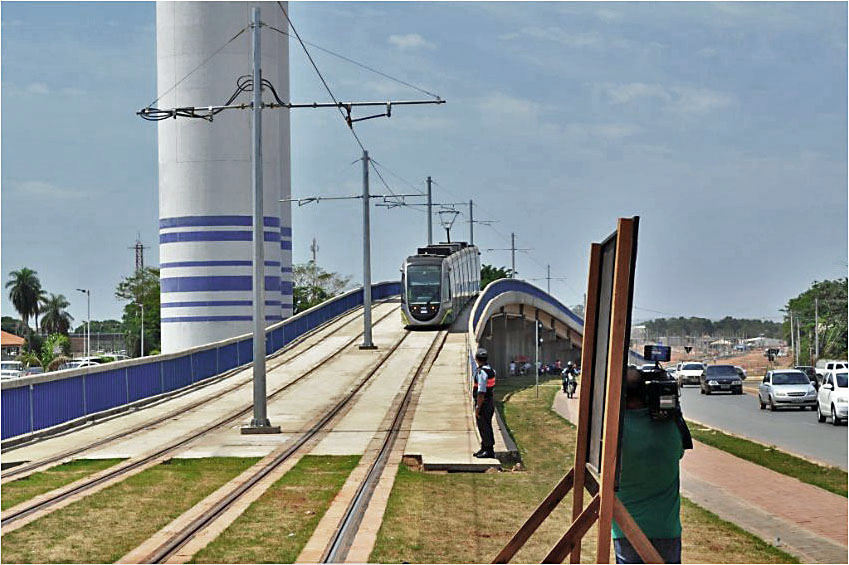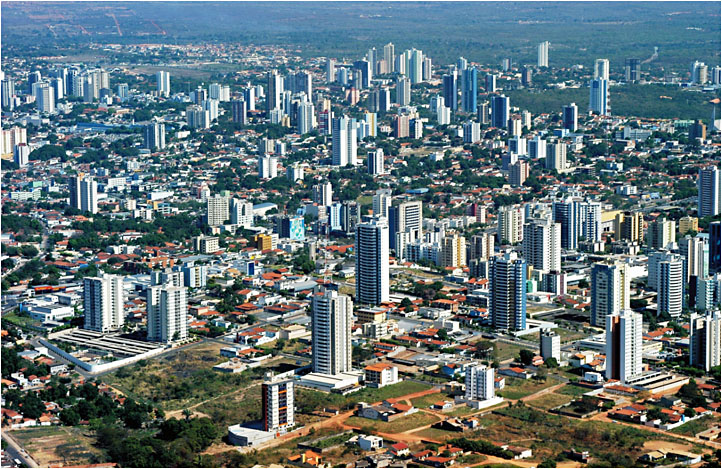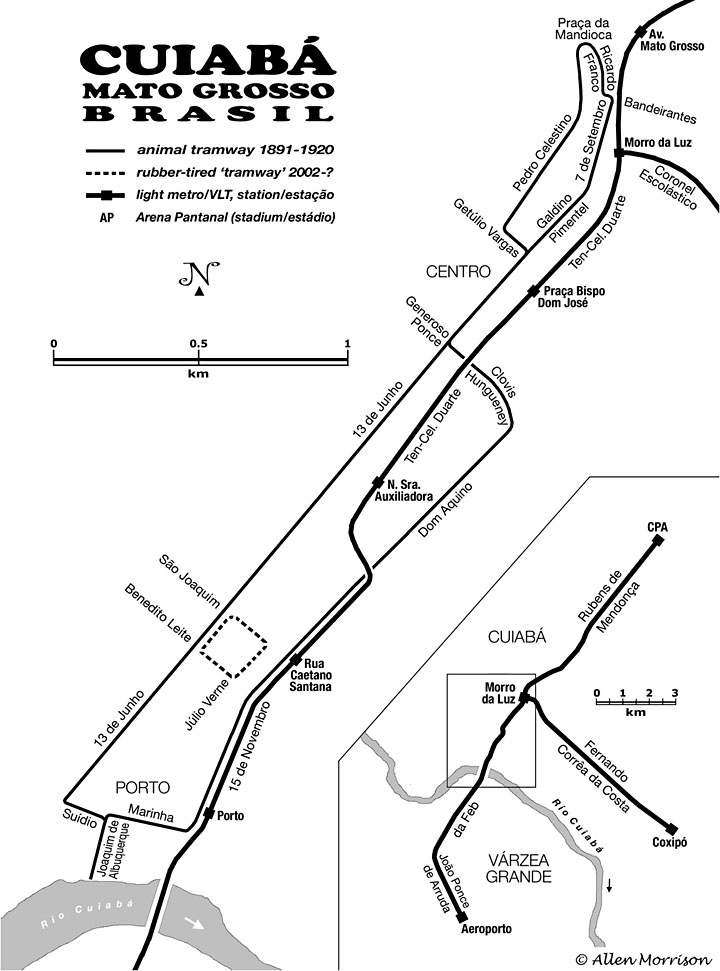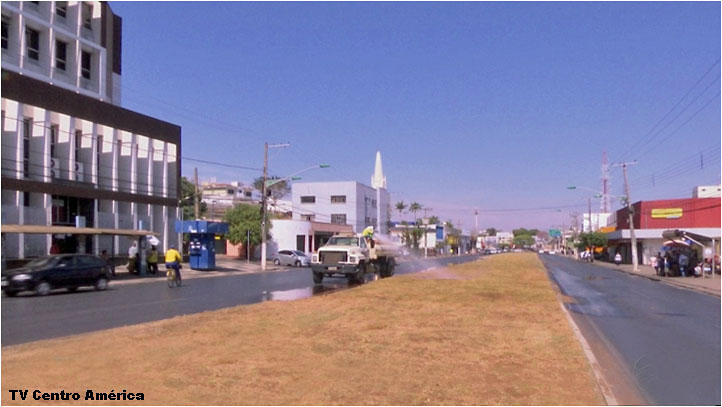C U I A B Á
from tram to LRV
do bonde ao VLT
by Allen Morrison
Residents of Cuiabá, the capital of Mato Grosso state, Brazil, claim that their city is in the geographical center of South America. True or not, it is certainly one of the most remote large cities in Brazil, far from its industrial centers along the Atlantic coast [see area map]. Cuiabá was never connected with the rest of Brazil by railroad, and until the air age travel from Rio de Janeiro meant a month-long, 6,115 km boat trip down the Atlantic coast and up rivers through Argentina and Paraguay. The city subsisted on agriculture, and on 5 September 1889 Manoel da Silva Monteiro and Joaquim Francisco de Matos secured a franchise to build a street railway between the river port and the town center [see map below]. The Companhia de Progresso Cuyabano began carrying passengers on 30 April 1891. Origin of its rolling stock is unknown. The Annuario Estatistico do Brazil of 1908-1912 [see BIBLIOGRAPHY] reported that the Empreza Cuyabana Ferro Carril e Matadouro owned eight passenger trams, four freight trams, 40 mules and 6.5 km of track – and carried 300,000 passengers in 1908. In addition to the Matadouro (slaughterhouse), ECFCeM also had a branch to a brewery. Pictures of Cuiabá trams are rare to non-existent. The engraving below appeared on p. 247 of the South America volume of Frank J. Carpenter's Geographical Reader, published in New York in 1899 [col. AM]:
Here is the best known photograph of a Cuiabá tram [col. AM]:
A painting by local artist Moacyr Freitas. The background is different, but the drawing of the tram itself seems to have been based on the photograph above [col. Wanderley Duck]:
This
rare French postcard shows the "tram line going to the port". If only
the photographer could have included a tram in his view! The exact
location of the port is unknown. There is no trace of it today [col.
AM]:
The tramway closed in 1920 and buses provided the city's only public transportation for the next eight decades. Around
2000 a local empresario, Eliezer Contúrbia Neves, researched the
city's transport history and, with the help of the Serviço Social
do Comércio, constructed four replica trams that ran on rubber tires [see article and picture].
The first of the new "Bondes Cuyabanos" began carrying passengers on 1
November 2002 around the block behind the SESC on Rua 13 de Junho [see article and map below]. No rails were laid. The city's second animal-drawn "tramway" seems not to have run very long. It is not known what became of the vehicles. Cuiabá in 2005:
In 2007, after the Fédération Internationale de Football Association ("FIFA") selected Brazil to host the 2014 World Cup, Brazil chose Cuiabá as one of 12 cities where the games would be played, and Cuiabá began plans to improve its transport system. A "BRT" (Bus Rapid Transit) network was suggested, but others thought the choice should be light rail or "VLT" (veículo leve sobre trilhos), the Brazilian term for LRV. The debate continued for four years, until Brazilian President Dilma Rousseff finally intervened in August 2011 and specified rail:
The 23 km Cuiabá VLT system will consist of two routes, which, except for viaducts and bridges, will operate entirely in the center meridians of existing roads in Cuiabá and Várzea Grande [see map above]. The airport is in Várzea Grande, which will also be the location of the VLT shops. It will be one of the few VLT lines in South America that is not built on former railroad rights-of-way. (Cuiabá has no railroad rights-of-way.) The first of 40 seven-section 400-passenger "Urbos" vehicles built at CAF's factory in Zaragoza, Spain, began arriving in November 2013. All 40 had arrived by June 2014 [CAF]:
The VLT consortium stopped construction again in December 2014, alleging widespread corruption, missing funds and premature purchase of the rolling stock, apparently when exchange rates were low. Trains continued to make test runs in 2015 over a viaduct alongside Av. João Ponce de Arruda, near the airport: |

|
But for the most part the 40 VLT trains (280 vehicles) have sat unused in the Várzea Grande yard for three years. Dusty, but the company claims that they have been well tended and are immaculate inside. Transport agents from Argentina, Spain and Portugal have shown interest – either in buying the equipment or in completing and running the line [olhardireto]:
In
2017 Mato Grosso governor Pedro Taques dissolved the Brazilian-Spanish consortium and
said he would finish the line himself, although he didn't say how.
Cuiabá mayor Emanuel Pinheiro announced that if the line
wasn't operating by January 2018 he would pave the
right-of-way – literally and figuratively bury the light rail system – with grass. It wasn't and he did. The following photograph was taken on Av. Tenente Coronel Duarte [see map] in July 2018 [TV Centro América]:
Cuiabá
is the capital of Mato Grosso state, center of what United World calls the
fastest-growing region in Brazil. Let us hope that something constructive will happen there soon ...
BIBLIOGRAPHY De volta ao tempo do bonde in Diário de Cuiabá of 18/4/2002. Background, preparations, picture of "tram". Os Bondes estão de volta in Diário de Cuiabá of 4/11/2002. Tram has been running since first of month. Small photograph. Mato Grosso. Prefeitura de Cuiabá, Prefeitura de Várzea Grande. Audiência Pública. Anteprojeto do Veículo Leve sobre Trilho. Impressive, 76-page PDF description of the rail project. Text, maps and many diagrams. (To download, click arrow under the word "Arquivos".) Construcciones y Auxiliar de Ferrocarriles (CAF). Data page on the "Tranvía Cuiabá". Text, stats and four illustrations. G1.globo.com/Mato-Grosso. Do Bondinho ao VLT, trilhos retornam a Cuiabá depois de quase um século. Nice article with drawings and pictures of trams and (rare) a tram ticket. Robert Schwandl. UrbanRail.Net. Cuiabá. Map and data. SkyscraperCity.com. VLT de Cuiabá e Várzea Grande. Forum for the latest news and illustrations.
See my index of If you have comments, criticism or suggestions, This site was first placed online on Copyright © 2013-2113 Allen Morrison |








